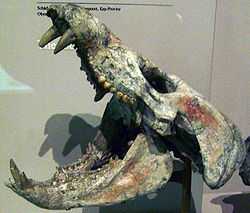Diademodon
From Wikipedia, the free encyclopedia
| Diademodon Temporal range: Middle Triassic | |
|---|---|
 | |
| Diademodon tetragonus skull at the Museum für Naturkunde, Berlin | |
| Scientific classification | |
| Kingdom: | Animalia |
| Phylum: | Chordata |
| Clade: | Synapsida |
| Order: | Therapsida |
| Clade: | Cynodontia |
| Family: | †Diademodontidae |
| Genus: | †Diademodon Seeley, 1894 |
| Type species | |
| †Diademodon tetragonus Seeley, 1894 | |
| Synonyms | |
|
Genus-level:
Species-level:
| |

Life restoration
Diademodon is an extinct genus of cynodont therapsid. It was about 2 metres (6.6 ft) long and probably omnivorous.[1] The genus was first described by paleontologist Harry Seeley in 1894 from the Karoo Basin of South Africa. Additional species were named by paleontologist A. S. Brink in 1979, although they are now considered synonyms of the type species Diademodon tetragonus. Fossils of the Diademodon tetragonus have more recently been found in deposits of the Rio Seco de la Quebrada Formation in Mendoza Province, Argentina.[2]
Other Related Genera
References
- ↑ Botha, J.; Lee-Thorp, J.; Chinsamy, A. (2005). "The palaeoecology of the non-mammalian cynodonts Diademodon and Cynognathus from the Karoo Basin of South Africa, using stable light isotope analysis". Palaeogeography, Palaeoclimatology, Palaeoecology 223 (3–4): 303. doi:10.1016/j.palaeo.2005.04.016.
- ↑ Martinelli, A. N. G.; Fuente, M. D. L.; Abdala, F. (2009). "Diademodon tetragonus Seeley, 1894 (Therapsida: Cynodontia) in the Triassic of South America and its biostratigraphic implications". Journal of Vertebrate Paleontology 29 (3): 852. doi:10.1671/039.029.0315.
| |||||||||||||||||||||||||||||||||||||||||||||||||||||||||||||||||||||||||||||||||||||||||||||||||||||||||||||||||||||||||||||||||||||
This article is issued from Wikipedia. The text is available under the Creative Commons Attribution/Share Alike; additional terms may apply for the media files.